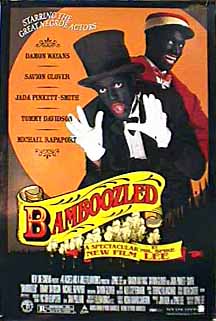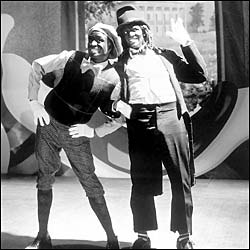
 |
 |
According to Amy Taubin in the Village Voice, "Lee has never made a secret of his anger toward In Living Color. In part, Bamboozled is an act of revenge on the show and on one of its creators and stars, Damon Wayans, who's made to pay for his success in more ways than one. Lee has done Wayans no favors by casting him as Bamboozled's snobbish, confused, and cowardly protagonist, Pierre Delacroix, a Harvard-educated television writer. Pressured by his white boss (Michael Rapaport), whose blacked-up pose he despises, to write a cutting-edge series, Delacroix finds his inspiration in Amos 'n' Andy and The Jeffersons. His program, Mantan: The New Millennium Minstrel Show, set in a watermelon patch and starring "two real coons," Mantan and Sleep 'N Eat, is so tauntingly racist that he expects to be fired for insubordination. Instead, the show is a huge hit. Delacroix pockets his check, but his repressed rage and guilt drive him over the edge. . . . If Bamboozled's primary story line is clumsy and badly acted, the subplot involving Manray (Savion Glover) and Womack (Tommy Davidson), homeless street performers who become overnight sensations when Delacroix casts them as Mantan and Sleep 'N Eat, is extremely moving and filled with possibilities. The movie comes to life in the backstage scenes, where they look at themselves in the mirror as they coat their faces with cork, paint their lips fire-engine red, and try to swallow their dismay at what they have to do to earn a living. Mantan's stardom enrages the Mau Maus, gangsta rappers with stereotypes of their own to account for. Eventually, the Mau Maus (whose members include Mos Def and Canibus) hijack the movie and turn it into a tragedy in cyberspace or maybe inside someone's psyche. Narrative consistency is not Lee's strong suit.
According to Andy Seiler in USA Today, "Spike Lee has always been more than just a filmmaker. His movies raise serious issues, and he himself is a bit of a provocateur, firing off angry letters to anyone he feels distorts his work. Now comes Bamboozled (opening Friday in select cities), a Molotov cocktail of a satire that argues that popular black entertainers of today are nothing more than players in racist minstrel shows. The movie's targets vary widely, and Lee is proud to reel off some of them: ''Ving Rhames, Cuba Gooding Jr., Whoopi Goldberg, Diana Ross, Will Smith, President Clinton, Mother Teresa, malt liquor, the Rev. Al Sharpton, Johnnie Cochran, In Living Color, UPN, the WB, Quentin Tarantino, D.W. Griffith, the NAACP, athletes, rappers and myself.'' So controversial is Bamboozled, shot before Lee's The Original Kings of Comedy, that a reported 11 movie studios rejected the film before New Line Cinema agreed to put it out. Yet Lee is unbowed, unbroken and unapologetic. ''The film has been brewing for me, subliminally probably,'' he says, ''from the first day I started watching television or started going to movies.'' He considers several current TV shows appalling, including Eddie Murphy's The PJs. ''
According to the interview with Lee in the Bergen Record, "This is my 15th feature film, and aside from the very first, "She's Gotta Have It," for which I raised $175,000 by myself, this was the hardest film to get made. Hollywood is very funny, because they never just want to say no, because they know that OK, I don't like this one, but down the line I don't want to mess up my relationship with Spike Lee. They'll say, "Spike, if you can get Will Smith and Leonardo DiCaprio to work for scale, then we'll make it for $8 million." Which is kind of like saying, "If you can walk to the moon, and come back, then we'll make the film." Then New Line Cinema stepped up, and we knew we'd have to do it for a price. So we committed to bring it in for under $10 million. . . I'm going to be honest. Ten years back, I thought Stepin Fetchit was an Uncle Tom. But I've evolved on this issue. I'm getting older, I'm becoming more mature, I've come to understand that unlike us today, they didn't have a choice. And these guys were good artists. Mantan Moreland, that guy was funny. Bill Bojangles -- I don't think it was his choice to spend the best years of his life dancing with Shirley Temple, you know, this 5-year-old mop head. Hattie McDaniel had the famous quote, "It's better to play a maid than be a maid." So, I've gained a much greater understanding of performers like that. But nowadays we have choices -- at least, more choices than Mantan Moreland or Stepin Fetchit. . . . The United States of America hasn't become the greatest power in the history of civilization because of its nuclear weapons. Movies, TV, rock-and-roll, rap, Coca-Cola, McDonald's, Levi's, Mickey Mouse -- that is why America is the world power. Our pop culture is why we dominate the world, not because of nuclear bombs. We still live with hurtful stereotypical images, and that's why I think "Bamboozled" is important."
According to Richard Corliss in Time, Lee "is an equal-opportunity annoyer. He condemns whites for manufacturing the old image of the shiftless, larcenous Negro and for still seeing blacks through that warped prism. He also chastises blacks for inhabiting restrictive new and polar-opposite categories: the gangsta and the Buppie. Satire typically proceeds from two impulses: rage at the powerful and contempt for the masses. Lee has both. Social and cinema history back him up. The first great movie epic (The Birth of a Nation) and the first talkie sensation (The Jazz Singer) wallowed in racial derision, personified by white actors in blackface. Mickey Rooney and Judy Garland, Fred Astair and Bugs Bunny defaced themselves in minstrel cork. Egregious stereotyping can still be heard, most mornings, on Don Imus' and Howard Stern's radio shows -- aural blackface. Somebody had to shout, "Enough," and, whaddaya know, it was Spike Lee."